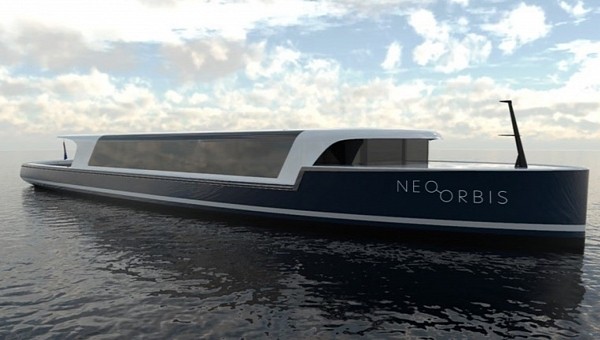All kinds of vessels have kicked off construction this month, but one of the most exciting ones is undoubtedly the Neo Orbis. A pioneering vessel in a pilot project that’s unfolding at the Port of Amsterdam, this green boat will run on hydrogen. Not simply hydrogen, but a fixed form of it, called “sodium borohydride,” which promises revolutionary benefits for sailing.
Claiming to be the largest petroleum port in the world, Port of Amsterdam has also been participating in numerous clean energy projects. Last year, it became the pilot port for H2Ships, a European initiative that’s all about the use of hydrogen for shipping.
As part of H2Ships, the port will operate a brand-new hydrogen-fueled vessel, called the Neo Orbis (Neo is Latin for “new,” and Orbis is Greek for “world”). The ship, for which the keel was recently laid, will have an interesting role. It’s meant to literally demonstrate the benefits of this innovative hydrogen-based technology, not by carrying cargo, but by taking customers (and even Royalty) around the area.
Until now, the port had operated a so-called “saloon boat” to take potential clients around the harbor locations, Amsterdam city center, and up the North Sea Canal. Once the Neo Orbis is ready to enter service, it will replace this conventionally-powered boat, while also acting as a demonstrator for the hydrogen technology that powers it. Its future passengers will include members of the Dutch royal family and government officials, and it will also serve as a floating platform for various meetings and events.
The main innovation is related to the way in which hydrogen is stored. That’s because storage is one of the most notorious challenges that come with this alternative fuel. Hydrogen gas takes up a lot of space to be safely stored, and it’s also highly inflammable. A new solid form of it, sodium borohydride ((NaBH4) would minimize this risk, while also being much more compact.
According to the Port of Amsterdam, this new form of hydrogen is comparable to fossil fuel in terms of energy density and safety, making it a much better option than the gaseous form. The Neo Orbis would use it to generate electricity as its only source of power, and the residual product (spent fuel) would be stored on board and processed once the boat reaches shore.
If you’re wondering about the costs of this new technology, they do seem to be a source of concern. However, it seems that the pilot project will simply ignore them for now, and focus on proving that the technology works, and that it can result not in lower emissions, but no emissions at all.
The sodium borohydride installation will be provided by TU Delft Fuel, the inventor of this technology, and the vessel is being built by Next Generation Shipyards.
In the future, the intention is to improve the system so that the spent fuel can be used to generate new sodium borohydride onboard, for a circular energy production cycle.
As part of H2Ships, the port will operate a brand-new hydrogen-fueled vessel, called the Neo Orbis (Neo is Latin for “new,” and Orbis is Greek for “world”). The ship, for which the keel was recently laid, will have an interesting role. It’s meant to literally demonstrate the benefits of this innovative hydrogen-based technology, not by carrying cargo, but by taking customers (and even Royalty) around the area.
Until now, the port had operated a so-called “saloon boat” to take potential clients around the harbor locations, Amsterdam city center, and up the North Sea Canal. Once the Neo Orbis is ready to enter service, it will replace this conventionally-powered boat, while also acting as a demonstrator for the hydrogen technology that powers it. Its future passengers will include members of the Dutch royal family and government officials, and it will also serve as a floating platform for various meetings and events.
The main innovation is related to the way in which hydrogen is stored. That’s because storage is one of the most notorious challenges that come with this alternative fuel. Hydrogen gas takes up a lot of space to be safely stored, and it’s also highly inflammable. A new solid form of it, sodium borohydride ((NaBH4) would minimize this risk, while also being much more compact.
According to the Port of Amsterdam, this new form of hydrogen is comparable to fossil fuel in terms of energy density and safety, making it a much better option than the gaseous form. The Neo Orbis would use it to generate electricity as its only source of power, and the residual product (spent fuel) would be stored on board and processed once the boat reaches shore.
If you’re wondering about the costs of this new technology, they do seem to be a source of concern. However, it seems that the pilot project will simply ignore them for now, and focus on proving that the technology works, and that it can result not in lower emissions, but no emissions at all.
The sodium borohydride installation will be provided by TU Delft Fuel, the inventor of this technology, and the vessel is being built by Next Generation Shipyards.
In the future, the intention is to improve the system so that the spent fuel can be used to generate new sodium borohydride onboard, for a circular energy production cycle.
Construction starts on hydrogen ship Neo Orbis which will serve Port of Amsterdam #hydrogen #greenhydrogenhttps://t.co/TiftR3XGXy
— EnergyNews.biz (@EnergyNews_Biz) January 24, 2023





